BACK PAGE |
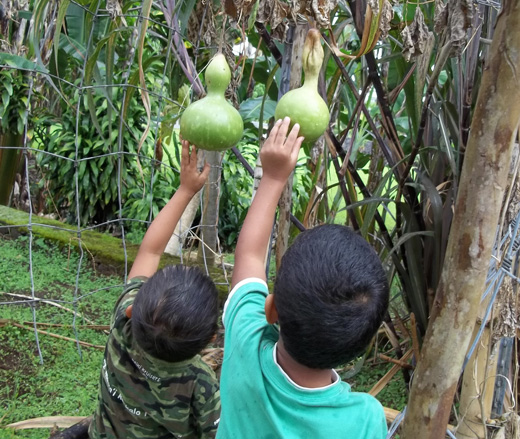 |
Fast-forward to the present, and The Kohala Center is now an organization focused on energy self-reliance, food self-reliance, and ecosystem health. In 2012, we’ve worked closely with the County of Hawai‘i to design a sustainable energy program with the potential to save taxpayers millions of dollars. We’ve worked with over 100 agricultural businesses, assisting them in building cooperatives, gaining them access to business planning services, and securing $2,900,000 in funds to support our local food system. In the area of ecosystem health, ReefTeachers at Kahalu‘u Bay made contact with over 39,000 visitors, educating them in ways to enjoy the bay while at the same time protecting its fragile coral reef. And through the tenacious work of the Kohala Watershed Partnership, 8,000 native plants have been outplanted, and 3,500 acres of land in North Kohala have been surveyed to significantly reduce the infestation of Rauvolfia vomitoria, a noxious, invasive tree.
We’ve created jobs and boosted the local economy. At The Center alone, we now have 20 full-time and five part-time employees, working with approximately 20 independent contractors in knowledge-rich fields such as expert fence-building, marine biology, public policy, curriculum design, geohydrology, geographic information science, Hawaiian cultural praxis, forest ecology, and microeconomics. A recent University of Hawai‘i study indicates that all this good work drives our local economy: at Kahalu‘u Bay, for example, every dollar invested in research and education generates two dollars in local business activity.
To ensure that island youth qualify for the jobs we are creating, we support science, mathematics, and environmental education in Hawai‘i Island schools, reaching 7,000 students last year. They are learning in 62 school gardens. They are learning by being environmental educators at Kahalu‘u Bay. They are learning by conducting their own research on ecosystem health—right in the forests and the ocean. The island is their school!
Yes, it feels like magic, but honestly, it’s the result of hard work and dedication powered by support from donors like you. For your generosity that has made all this possible, we thank you! We hope you’ll continue to make this magic happen with a tax-deductible contribution. Your support inspires and enables our critical work for our island planet’s future.
Mahalo nui loa.
Sincerely yours,
Matthews M. Hamabata, Ph.D.
Executive Director
Kahaluʻu Bay Education Center Celebrates First Anniversary
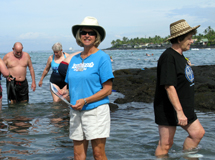 |
 |
Kahalu‘u Bay receives, on average, 400,000 visitors a year that flock to the small beach park to enjoy some of the finest snorkeling Hawai‘i has to offer. Many of these visitors unknowingly and innocently step on the bay’s live corals, unaware they are literally trampling them to death. In KBEC’s first official year of operations, staff and ReefTeach volunteers educated an estimated 39,000 of those visitors on proper reef etiquette, teaching swimmers and snorkelers where to stand, and advising them to stay afloat when swimming near or over the corals.
“Since its inception, ReefTeach has given the corals, reef, and wildlife a fighting chance, while still allowing visitors to enjoy the bay,” says Matt Connelly, KBEC’s Volunteer Coordinator and Trainer. “Our goal is to create a balance between our visitors and the bay and its inhabitants. We do it to protect Kahalu‘u, one of our island’s most treasured cultural assets. And we do it with a spirit of aloha: our visitors are generally grateful for the friendly education we provide, and very thankful for our efforts to take care of this beautiful place.”
Mahalo to our hardworking volunteers and staff!
While ReefTeach volunteers primarily interact with the public, KBEC’s Citizen Science volunteers work behind the scenes (and below the surface) to monitor the bay’s health. Citizen Scientists are trained to collect essential water samples and data twice a week from six predetermined collection sites in the bay. Conditions such as tide level and weather conditions are noted, and the samples are tested onsite for temperature, pH, salinity, turbidity, and dissolved oxygen. Thanks to funding from the National Science Foundation, all data are then entered into an online portal created specifically for Kahalu‘u Bay by the University of Hawai‘i at Mānoa’s Center for Conservation Research and Training. Citizen Science allows volunteers of all ages to gain hands-on, real-world training and experience in water quality monitoring and measurement, while providing a sense of fulfillment that their efforts are contributing to the future health and protection of our beloved bay.
We are eternally grateful to our tireless volunteers for the tens of thousands of hours they have given to the bay. As a way to show our appreciation, we honored them in October with a pupu party generously donated by Jackie Rey’s ‘Ohana Grill. KBEC, ReefTeach and Citizen Science volunteers had the chance to enjoy ono local food, meet KBEC and Kohala Center staff, and talk story. (View photos of our Volunteer Appreciation Party by photographer John Wicart.) KBEC, The Kohala Center, Lefty, and all the inhabitants of Kahaluʻu Bay wish to extend our warmest mahalo to our amazing volunteers!
The Kahalu‘u Bay Education Center relies on the generosity of volunteers, grant support, and donations from readers like you. You can make a tax-deductible donation online by clicking here. Mahalo for your kokua!
Bee the Change: What Is Happening to Our Honeybees?
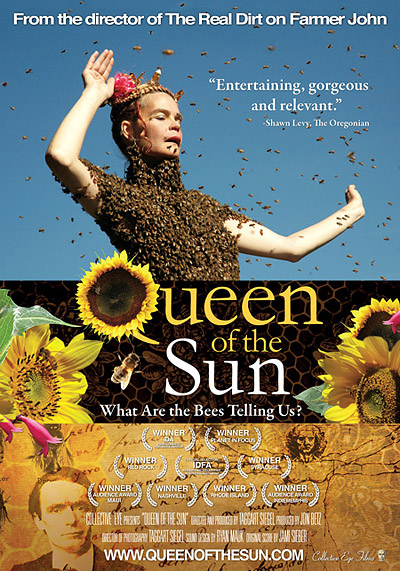 |
 |
While not a native species, honeybees have been on our islands for centuries, and farmers depend on them to pollinate many of their crops. Bees have been essential agents in the local movement toward greater food self-reliance and abundance. But today, bee colonies here and worldwide are facing a variety of threats, which are weakening them and causing their numbers to drop, in turn impacting our food supplies.
“Bees are the primary pollinators of many of the fruits and vegetables grown here in Hawai‘i,” says Nancy Redfeather, Project Director for The Kohala Center’s Hawai‘i Island School Garden Network. “Our local food supply depends on them.”
Students in Hawai‘i Academy of Arts and Sciences’ beekeeping class light smokers used to calm bees.
There are many factors thought to be contributing to the declining health of our planet’s bee colonies. Replacing honeybees’ natural food sources with sugar water or high-fructose corn syrup is a common practice among non-organic honey producers that may be having an impact. Pollination of genetically modified (GM) crops may be another. In Hawai‘i, the introduction of two parasites is also posing a significant threat: the varroa mite, a tiny parasite that feeds on the blood of weaker bees, and the hive beetle, which eats bee eggs, larvae, honey, wax, pollen, and other hive materials. Colonies are growing smaller or, in some cases, retreating to the forests to build new hives, and thus not pollinating agricultural lands.
“We have to help make our bees and colonies stronger through better stewardship,” says Redfeather. “Our ‘Bee the Change’ event will be a fascinating and informative evening that will educate the public and help them understand how they can be part of the solution.”
“Bee the Change” will take place on January 25, 2013 from 6:00 to 9:30 p.m. at the Gates Performing Arts Center at Hawai‘i Preparatory Academy in Waimea, 65-1692 Kohala Mountain Rd. Admission is free; please RSVP via e-mail.
Seed Basics Workshops: The Root of Food Security
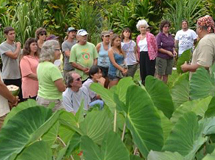 Workshop participants receive in-field demonstrations and instruction.
Workshop participants receive in-field demonstrations and instruction.Funded by a Ceres Trust grant awarded to The Kohala Center, Seed Basics Workshops were previously held on Kaua‘i, Maui, Moloka‘i, and O‘ahu and were attended by 150 participants. Thirty farmers and home gardeners attended the Hawai‘i Island workshop, held at the Amy Greenwell Ethnobotanical Garden in Captain Cook on November 3 and 4, 2012. Workshops included both lecture presentations and fieldwork, giving participants hands-on practice in harvesting, selecting, cleaning, and storing fresh seed. Each workshop included a basic focus on growing lettuce and tomato to seed, as well as taro propagation. Strategies to account for differences in elevation, weather patterns, and rainfall were also discussed.
The Hawai‘i Island workshop included a number of distinguished and credentialed presenters, including:
• Hector Valenzuela, Ph.D., Vegetable Specialist, University of Hawai‘i College of Tropical Agriculture and Human Resources (CTAHR) Extension
• Russell Nagata, Ph.D., former Lettuce Plant Breeder and current University of Hawai‘i at Mānoa CTAHR Hawai‘i County Administrator
• Glenn Teves, Cooperative Extension Service Agent, CTAHR Moloka‘i Extension Office
• Nancy Redfeather, Program Director, Hawai‘i Public Seed Initiative; Program Director, Hawai‘i Island School Garden Network; Co-Owner, Kawanui Farm
• Paul Massey, President and Director, Regenerations Botanical Garden, Kaua‘i; Manager, The Kaua‘i Community Seed Bank
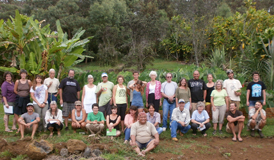
“Seeds can be a precious commodity to gardeners, especially when they represent links to our being, as would heirloom seeds handed down from one generation to the next,” said Nagata. “They are the starting point of many good things. Without seeds, the world we know would not exist.”
The workshop agenda and presentations are available to the public online. Moving forward, the Public Seed Initiative plans to facilitate a “Train the Trainers” Workshop in 2013, with the goal of furthering seed production, education, and promotion of sustainable seed networks on each island.
BELL Hawai‘i Scholarship Opportunity
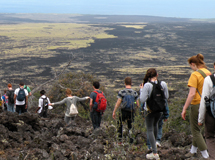 |
BELL-Hawai‘i students entering the Ka‘ūpūlehu Dryland Forest, with Kailua-Kona below.
The 2013 BELL Hawai‘i program runs from March 22-29, and features a wide range of workshops and presentations focusing on marine science, geology, volcanology, and traditional Polynesian crafts. This spring, a group of 30 students will have an opportunity to kayak and snorkel at some of Hawai‘i Island’s most pristine coral reefs, hike through lava tubes, explore native rain forests, conduct service work in rare dry forests, and talk story with respected kūpuna (native Hawaiian elders).
Highlights of this year’s program include:
• Sian Olsen, owner and operator of Kohala Kayak, will take students on a guided kayak tour of Hawai‘i’s coral reefs.
• Rob and Susan McGovern of Elderhostel, Inc. will guide the group on multiple hikes in Hawai‘i Volcanoes National Park to explore lava tubes, craters, steam vents, and historic lava flows.
• Lyn Howe and Geoff Rauch, organic eco-farmers, will explain sustainable farming practices and lead the students on a tour of their off-grid farm, where they will have the opportunity to sample locally grown fruits.
• Wilds Brawner and Yvonne Carter will teach students about the rare endemic species found in the Ka‘ūpūlehu Dryland Forest, and the group will help with outplanting of native species and pulling invasive weeds.
• Ku‘ulei Keakealani, curator at the Ka‘ūpūlehu Interpretive Center at Kalaemano, will guide the group around this ancient salt-making and Hawaiian petroglyph site.
The Kohala Center and Brown University are once again partnering to offer one full-tuition scholarship to a Hawai‘i Island high school student. The application deadline for Hawai‘i Island students wishing to apply for this scholarship is January 4, 2013. The student who is awarded this scholarship will also be required to complete Brown University’s application by January 28, 2013. For more information and online links to application materials, visit the BELL Hawai‘i Web site.
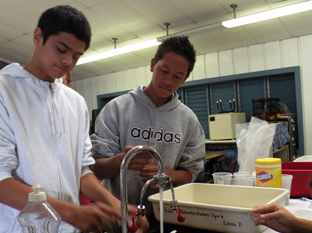
Students conduct water quality tests during an in-class activity at Ke Kula ‘O Nāwahīokalani‘ōpu‘u.
Spending all day in a classroom can inhibit a student’s focus and grasp of what they’re being taught. The Hawai‘i Island Meaningful Outdoor Experiences for Students (HI-MOES) provides island students and teachers with resources to apply knowledge by bringing learning outside, using our remarkable island classroom as an ideal setting for hands-on, place-based education.
2012-2013 marks the fourth school year in which The Kohala Center has administered a place-based inquiry learning program, serving Hawai‘i Island’s middle- and high-school students and teachers. HI-MOES is made possible with a grant from the National Oceanic and Atmospheric Administration’s Bay Watershed Education and Training (B-WET) Program. Twelve teachers from ten island schools were selected from a field of 15 applicants.
This year’s HI-MOES teachers are:
• Frannie Rinslow (Science), Laupāhoehoe Intermediate School
• Ilana Stout (Environmental Science), Kea‘au High School
• Jo'el Nathansen (Marine Biology), Kea‘au High School
• Mahina Patterson (Life and Earth Science), Ke Kula ‘O Nāwahīokalani‘ōpu‘u
• Katherine Roseguo (Science), Ke Kula ‘O Nāwahīokalani‘ōpu‘u
• Charlotte Romo (Science), Kalanianaole Elementary & Intermediate School
• Tina Doherty (Science), Parker School
• Jason Trimble (A.P. Environmental Science), Honoka‘a High School
• Laura Jim (Science), Hawai‘i Preparatory Academy
• Mari Taira (Science), Waikoloa Elementary and Middle School
• Eliosa Bellah (Biology), Kealakehe High School
• Megan Dehning (Physical Science), Innovations Public Charter School
“Many of our state’s schools lack the budgets, resources and logistical support to offer place-based learning programs,” said Erica Perez, Expeditionary Learning Coordinator at The Kohala Center.
“HI-MOES provides the support, resources, and curriculum necessary to aid schools in providing these great opportunities for students to spend time outside, applying what they’re taught in the classroom in their own backyard. It also gives students a greater appreciation for all that Hawai‘i Island has to offer.”
Perez, the Expeditionary Learning Coordinator for The Kohala Center and Melora Purell, Kohala Watershed Partnership Coordinator, travel to participating schools to deliver presentations on watershed and ecosystem health. Their curriculum teaches students about human impacts on watershed systems, types and sources of pollutants, water quality sampling and methodologies, while also integrating sociocultural issues and practices related to the watersheds they are studying.
Students and teachers then embark on their expeditions to apply and gain even greater knowledge at various outdoor learning sites around the island. Recent expeditions include:
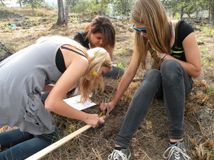
• Innovations Public School’s excursion to Pu‘u Wa‘awa‘a. Elliott Parsons with Three Mountain Alliance spoke to students about invasive species taking over the delicate dryland forest, as well as reforestation and outplanting efforts to reforest and restore the area. The Innovations Public Charter School team engaged in eradicating invasive plant species, and conducted service learning through data collection of koki‘o (hibiscus) growth rates.
Students of Innovations Public Charter School collecting growth rate data of the endemic koki‘o tree.

• Ke Kula ‘O Nāwahīokalani‘ōpu‘u’s inquiry excursion at Waiopae Marine Life Conservation District, led by John Burns with the University of Hawai‘i at Hilo Tropical Conservation Biology and Environmental Science program along with Erica Perez, completed observations of the site. The school’s students are learning about and eradicating mangroves, an invasive marine tree that threatens tide pools and coral gardens.
Ke Kula ‘O Nāwahīokalani‘pu‘u students collecting observational data during the first field outing to Waiopae Marine Life Conservation District.
This year’s HI-MOES program will culminate in an island-wide conference on April 19, 2013, at which student teams will present the research, findings, and conclusions of their projects. The students and teachers will also hear from working scientists who will talk about research and tie the students’ hands-on experiences to “real world” careers. Students will also have their research published in a journal resulting from the conference.
More information about the HI-MOES program is available here.
Our mailing address is: |
 |
 |
Copyright © 2012 The Kohala Center. All rights reserved. |
|
FRONT PAGE |
